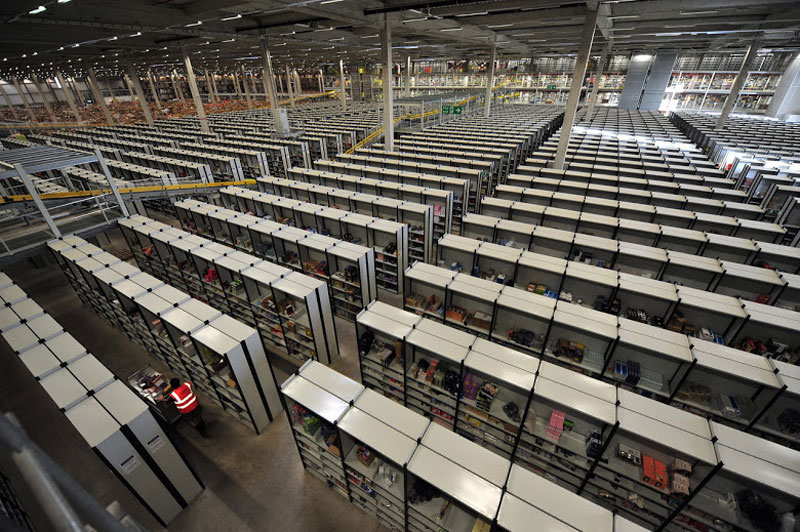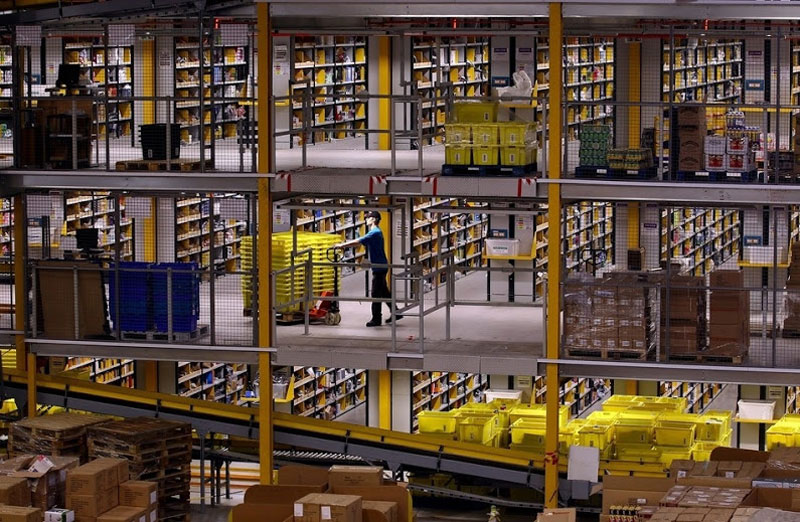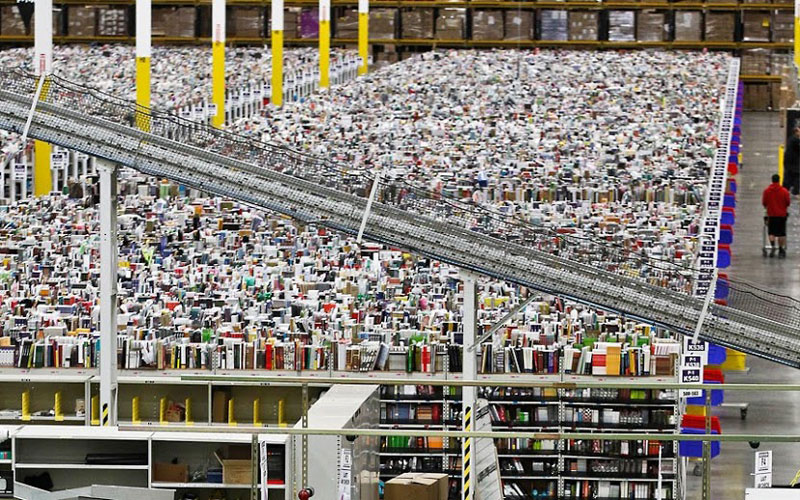
As the world’s largest online retailer, Amazon needs somewhere to put all of those products. The solution? Giant warehouses. Over eighty to be exact. Strategically located near key shipping hubs around the world.
The warehouses themselves are massive, with some over 1.2 million square feet in size (111,484 sq m). And at the heart of this global operation are people (over 65,000 of them), and a logistics system known as chaotic storage.

Chaotic storage is like organized confusion. It’s an organic shelving system without permanent areas or sections. That means there is no area just for books, or a place just for televisions (like you might expect in a retail store layout). The product’s characteristics and attributes are irrelevant. What’s important is the unique barcode associated with every product that enters the warehouse.

Every single shelf space inside an Amazon warehouse has a barcode. And every incoming product that requires storage is assigned a specific barcode that matches the shelf space in which it will be stored. This allows free space to be filled quickly and efficiently.
At the heart of the operation is a sophisticated database that tracks and monitors every single product that enters/leaves the warehouse and keeps a tally on every single shelf space and whether it’s empty or contains a product.

There are several key advantages to the chaotic storage system. First is flexibility. With chaotic storage, freed-up space can be refilled immediately. Second is simplicity. New employees don’t need to learn where types of products are located. They simply need to find the storage shelf within the warehouse. You don’t need to know what the product is, just where it is. Lastly is optimization.
Amazon must handle millions and millions of orders. That means that at any given moment there is a long list of products that need to be ‘picked’ from the shelves and prepared for shipment.
Since there is a database that knows every product required for shipment and the location of each product inside the warehouse, an optimized route can be provided to employees responsible for fulfillment.

Since Amazon deals with such a wide variety of products there are a few exceptions to the rule. Really fast-moving articles do not adhere to the same storage system since they enter and leave the warehouse so quickly. Really bulky and heavy products still require separate storage areas and perishable goods are not ideal for obvious reasons.

In this storage system a wide variety of products can be found located next to each other. A necklace could be located beside a DVD and underneath a set of power tools. This arbitrary placement can even help with accuracy as it makes mix-ups less likely when picking orders for shipment.
Overall it’s a fascinating system that at its core is powered by a complex database yet run by a simple philosophy. It’s Chaotic Storage. There’s no better way to put it 🙂

As the world’s largest online retailer, Amazon needs somewhere to put all of those products. The solution? Giant warehouses. Over eighty to be exact. Strategically located near key shipping hubs around the world. The warehouses themselves are massive, with some over 1.2 million square feet in size (111,484 sq m). And at the heart of this global operation are people (over 65,000 of them), and a logistics system known as chaotic storage. Chaotic storage is like organized confusion. It’s an organic shelving system without permanent areas or sections. That means there is no area just for books, or a place just for televisions (like you might expect in a retail store layout). The product’s characteristics and attributes are irrelevant. What’s important is the unique barcode associated with every product that enters the warehouse. Every single shelf space inside an Amazon warehouse has a barcode. And every incoming product that requires storage is assigned a specific barcode that matches the shelf space in which it will be stored. This allows free space to be filled quickly and efficiently. At the heart of the operation is a sophisticated database that tracks and monitors every single product that enters/leaves the warehouse and keeps a tally on every single shelf space and whether it’s empty or contains a product. There are several key advantages to the chaotic storage system. First is flexibility. With chaotic storage, freed-up space can be refilled immediately. Second is simplicity. New employees don’t need to learn where types of products are located. They simply need to find the storage shelf within the warehouse. You don’t need to know what the product is, just where it is. Lastly is optimization. Amazon must handle millions and millions of orders. That means that at any given moment there is a long list of products that need to be ‘picked’ from the shelves and prepared for shipment. Since there is a database that knows every product required for shipment and the location of each product inside the warehouse, an optimized route can be provided to employees responsible for fulfillment. Since Amazon deals with such a wide variety of products there are a few exceptions to the rule. Really fast-moving articles do not adhere to the same storage system since they enter and leave the warehouse so quickly. Really bulky and heavy products still require separate storage areas and perishable goods are not ideal for obvious reasons. In this storage system a wide variety of products can be found located next to each other. A necklace could be located beside a DVD and underneath a set of power tools. This arbitrary placement can even help with accuracy as it makes mix-ups less likely when picking orders for shipment. Overall it’s a fascinating system that at its core is powered by a complex database yet run by a simple philosophy. It’s Chaotic Storage. There’s no better way to put it 🙂
Amazon, It’s Warehouses And The Brilliant Use Of Chaotic Storage
Amazon, It’s Warehouses And The Brilliant Use Of Chaotic Storage
2015-03-10
admin
User Rating: 4.38 ( 2 votes)
0







